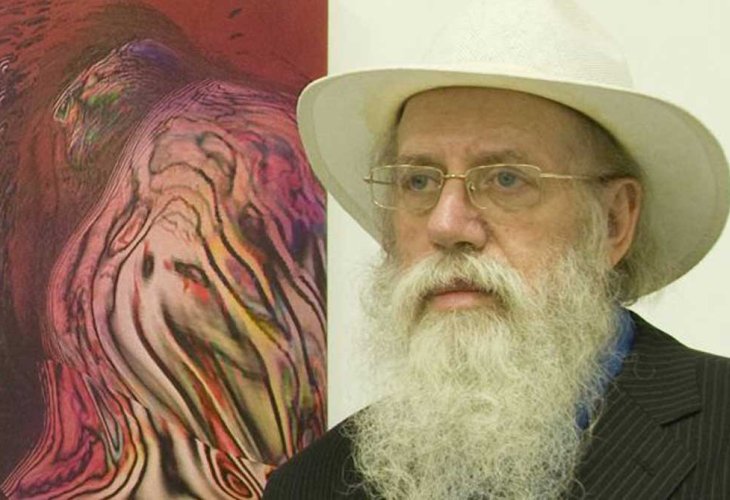Personal Stories
A Brush with Torah: The Artist Who Painted His Way to Judaism
A filmmaker turned painter shares how Hasidic teachings and Jewish identity transformed his life and his art
 Artist Dov Lederberg
Artist Dov LederbergDov Lederberg is an artist and painter who describes himself as a baal teshuva—a returnee to Jewish observance. But as he tells his story, it becomes clear that he never really turned away. Even during the years when Judaism seemed distant, he always held a warm place in his heart for Hashem and His Torah.
Dov was born in Philadelphia to Israeli parents. His father, a learned Torah scholar, had served as a rabbi, while his mother taught in the local Hebrew school. “We belonged to the Orthodox community,” Dov remembers. “But when I was around 13, my father became ill and was paralyzed. He had to step down from his role as synagogue rabbi. That changed everything for me. I began drifting, looking for myself in other places.”
In 1950s America, distractions weren’t hard to find. Dov tried to keep mitzvot (Jewish commandments) at home, not wanting to upset his parents, but as soon as he stepped outside, he left Jewish practice behind.
Decades passed. Today, it's hard to picture the gentle, spiritual artist as a restless teen. He begins his mornings immersed in Torah, especially teachings from Chassidut (mystical Jewish philosophy), and only afterward picks up a brush to paint. “I don’t create anything before learning,” he says. “The inspiration comes from Torah.”
Dov is a direct descendant—ninth generation—of the Maggid of Mezritch, one of the early leaders of the Chassidic movement. “I’m sure he worked hard for me in Heaven,” he says, tears in his eyes. “It’s thanks to him I found my way back.”
But how did that turning point happen?
Dov had been studying at a secular high school and later at Columbia University, focusing on psychology, photography, and filmmaking. “I was drifting farther and farther from Judaism,” he says. “I felt successful and on top of the world. My films were even winning awards.”
Then, one day, while working on a film, he visited the Lubavitcher Rebbe’s court in Brooklyn. It was Erev Rosh Hashanah (the day before the Jewish New Year), and out of curiosity, Dov stayed for the holiday prayers.
“I heard the Rebbe blow the shofar,” he recalls. “It melted me. The sound pierced my heart. It was so pure, so real—it awakened something deep inside me. In that moment, I knew clearly where I belonged.”
Instead of returning home, Dov enrolled in Hadar HaTorah—the world’s first yeshiva for baalei teshuva (Jews returning to observance). “I was in the very first class there,” he says.
After two years, his parents decided to return to Israel, and Dov, now strengthened in learning and observance, went with them.
But settling in Israel wasn’t easy. “I didn’t fit in,” he admits. “In America, you can just be yourself. Here, people expect you to belong to a ‘group.’ I didn’t fit any category.”
Still, he didn’t give up. “I told myself—I have a background in filmmaking, and now I have faith too. So why not create Jewish films?”
Without overthinking it, Dov walked into the Israeli Broadcasting Authority and offered to produce films about Judaism. It was bold, and to his own surprise, it worked. “I was probably the only one, before Hidabroot ever existed, who succeeded in airing Jewish films on Israeli television,” he says.
His documentaries featured the Lubavitcher Rebbe, Chassidic communities, and teachings about Torah values. “It was unbelievable,” he says. “But eventually, I was let go. They realized the films were bringing people back to Yiddishkeit (Judaism), and that was too much for them. Still, I’m proud of every second I was there. It felt like a mission.”
Dov didn’t stop creating. Inspired by his wife, the talented artist Yael Avi-Yonah (of blessed memory), he picked up a paintbrush. Yael was the daughter of Professor Michael Avi-Yonah, who famously designed the detailed model of the Second Beit HaMikdash (Holy Temple).
“Her art inspired me,” Dov says. “I decided to join her in painting. I left filmmaking behind and started painting full-time. Some of our best work was created together.”
But finding a place to exhibit his work wasn’t easy. “Secular galleries told me my work was too ‘Jewish,’ and in religious communities, there simply wasn’t a space for art at all,” he explains. “Back then, it was rare for a charedi (ultra-Orthodox) Jew to be an artist.”
That’s changed dramatically over the years. “Today, there are many religious artists, and people understand that art itself isn’t a contradiction to Torah. What matters is the message behind it.”
Dov now creates at least one painting a week. His favorite series is called “Dialogue,” which explores how a person sees themselves—during times of difficulty, closeness, or longing. “I took inspiration from the midrash (rabbinic teachings) about the keruvim—the angelic figures in the Temple that represented the relationship between the Jewish people and the Shechinah (Divine Presence),” he says.
His works are exhibited in his Safed gallery and in galleries around the world, sometimes selling for over $10,000. “But what brings me the most joy is incorporating the holy letters of the Hebrew alphabet into my paintings,” he shares. “The letters themselves are so rich with meaning. I began to embed them into my art to add a deeper, more spiritual dimension.”
Do the letters have a specific meaning in his work? Dov smiles. “There’s no one meaning,” he says. “Like the Torah itself—turn it and turn it, because everything is in it. Each viewer will see something different. And that’s the whole point.”

